Category Archives: Back Issues
Spring 2014, Vol. 73, No. 1
Artist’s Project Karen L. Schiff, Counter to Type Drawings appear on the front and back covers of this issue, on pages 2-3, on pages 5–11 with the artist’s essay, “Connecting the Dots/Hijacking Typography,” and in the Reviews section, pages 76–85.
Spring 2014, Vol. 73, No. 1
Artist’s Project Karen L. Schiff, Counter to Type Drawings appear on the front and back covers of this issue, on pages 2-3, on pages 5–11 with the artist’s essay, “Connecting the Dots/Hijacking Typography,” and in the Reviews section, pages 76–85.
Winter 2012, Vol. 71, No. 4
In This Issue Katy Siegel, Shaping the Glass, 5 Artist’s Project Tomma Abts, Untitled, 8 Features Christine Mehring, Richter’s Willkür, 20 Carrie Moyer, Zero to the Bone: Louise Fishman Speaks with Carrie Moyer, 36 Elyse Speaks, The Terms of Craft
Winter 2012, Vol. 71, No. 4
In This Issue Katy Siegel, Shaping the Glass, 5 Artist’s Project Tomma Abts, Untitled, 8 Features Christine Mehring, Richter’s Willkür, 20 Carrie Moyer, Zero to the Bone: Louise Fishman Speaks with Carrie Moyer, 36 Elyse Speaks, The Terms of Craft
Summer 2013, Vol. 72, No. 2
Features Alexandra M. Kokoli, The Voice as Uncanny Index in Susan Hiller’s The Last Silent Movie, 6 Kristen Olds, “Gay Life Artists”: Les Petites Bonbons and Camp Performativity in the 1970s, 16 Forum: Conversations on Queer Affect and Queer Archives
Summer 2013, Vol. 72, No. 2
Features Alexandra M. Kokoli, The Voice as Uncanny Index in Susan Hiller’s The Last Silent Movie, 6 Kristen Olds, “Gay Life Artists”: Les Petites Bonbons and Camp Performativity in the 1970s, 16 Forum: Conversations on Queer Affect and Queer Archives
Spring 2013, Vol. 72, No.1
Editor’s Note Lane Relyea, 5 Features Peggy Wang, Art Critics as Middlemen: Navigating State and Market in Contemporary Chinese Art, 1980s–1990s, 6 Michael Jay McClure, If It Need Be Termed Surrender: Trisha Donnelly’s Subjunctive Case, 20 Artist’s Project Moyra Davey,
Spring 2013, Vol. 72, No.1
Editor’s Note Lane Relyea, 5 Features Peggy Wang, Art Critics as Middlemen: Navigating State and Market in Contemporary Chinese Art, 1980s–1990s, 6 Michael Jay McClure, If It Need Be Termed Surrender: Trisha Donnelly’s Subjunctive Case, 20 Artist’s Project Moyra Davey,
Fall 2012, Vol. 71, No. 3
In This Issue Katy Siegel, Attention Deficit, 5 Features Chris Balaschak, Planet of the Apes: John Szarkowski, My Lai, and The Animals, 6 Adele Nelson, Sensitive and Nondiscurive Things: Lygia Pape and the Reconception of Printmaking, 26 Pamela N. Corey,Crafted
Fall 2012, Vol. 71, No. 3
In This Issue Katy Siegel, Attention Deficit, 5 Features Chris Balaschak, Planet of the Apes: John Szarkowski, My Lai, and The Animals, 6 Adele Nelson, Sensitive and Nondiscurive Things: Lygia Pape and the Reconception of Printmaking, 26 Pamela N. Corey,Crafted

Winter 2013, Vol. 72, No. 4
Artist’s Project Jeanne Dunning,Tom Thumb, the New Oedipus, 5 Features Forum: Sexing Sculpture: New Approaches to Theorizing the Object Jillian Hernandez and Susan Richmond, Introduction, 27 Rachel Lachowicz, Portfolio: Material Specificity and the Index of the Feminine, 30 Rachel Middleman,Rethinking

Winter 2013, Vol. 72, No. 4
Artist’s Project Jeanne Dunning,Tom Thumb, the New Oedipus, 5 Features Forum: Sexing Sculpture: New Approaches to Theorizing the Object Jillian Hernandez and Susan Richmond, Introduction, 27 Rachel Lachowicz, Portfolio: Material Specificity and the Index of the Feminine, 30 Rachel Middleman,Rethinking
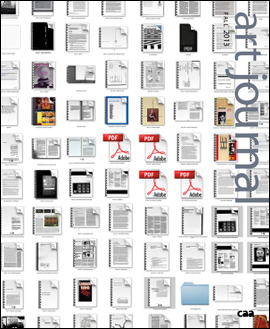
Fall 2013, Vol. 73, No. 3
Karin Higa: A Collage of Remembrances, 5 Artist’s Project Sara Greenberger Rafferty, Grabs, 1, 47, 64, 82, 91, 104 Features Matthew Goulish, “A Clear Day and No Memories”: Neurology, Philosophy, and Analogy in Kerry Tribe’s H.M., 12 Atreyee Gupta, In

Fall 2013, Vol. 73, No. 3
Karin Higa: A Collage of Remembrances, 5 Artist’s Project Sara Greenberger Rafferty, Grabs, 1, 47, 64, 82, 91, 104 Features Matthew Goulish, “A Clear Day and No Memories”: Neurology, Philosophy, and Analogy in Kerry Tribe’s H.M., 12 Atreyee Gupta, In
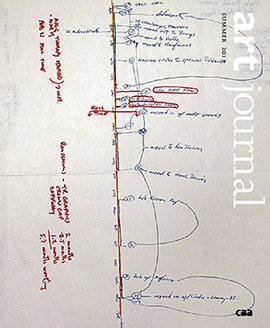
Summer 2013, Vol. 72, No. 2
Features Alexandra M. Kokoli, The Voice as Uncanny Index in Susan Hiller’s The Last Silent Movie, 6 Kirsten Olds, “Gay Life Artists”: Les Petites Bonbons and Camp Performativity in the 1970s, 16 Forum: Conversations on Queer Affect and Queer Archives

Summer 2013, Vol. 72, No. 2
Features Alexandra M. Kokoli, The Voice as Uncanny Index in Susan Hiller’s The Last Silent Movie, 6 Kirsten Olds, “Gay Life Artists”: Les Petites Bonbons and Camp Performativity in the 1970s, 16 Forum: Conversations on Queer Affect and Queer Archives
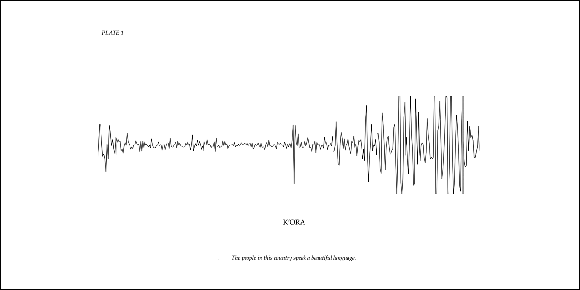
The Voice as Uncanny Index in Susan Hiller’s The Last Silent Movie
In the darkened projection room, the viewer hears twenty-five voices in succession speaking short passages in extinct or endangered languages. Susan Hiller collected the recordings for her twenty-one-minute audiovisual work The Last Silent Movie from a variety of archival sources.

The Voice as Uncanny Index in Susan Hiller’s The Last Silent Movie
In the darkened projection room, the viewer hears twenty-five voices in succession speaking short passages in extinct or endangered languages. Susan Hiller collected the recordings for her twenty-one-minute audiovisual work The Last Silent Movie from a variety of archival sources.
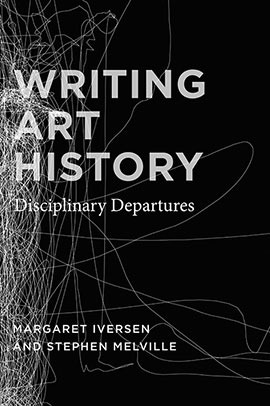
Where Do We Come From? What Are We? Where Are We Going?
By Sarah Betzer
Spurred by global economic contractions, by the attention of politicians, legislators, and pundits, and certainly also by the historical curiosity and critical orientation of its ranks, the academy at present is in the thrall of self-scrutiny. What is the past, present, and future of the research university, an invention of stunningly recent vintage and yet of remarkable structural resilience?

Where Do We Come From? What Are We? Where Are We Going?
By Sarah Betzer
Spurred by global economic contractions, by the attention of politicians, legislators, and pundits, and certainly also by the historical curiosity and critical orientation of its ranks, the academy at present is in the thrall of self-scrutiny. What is the past, present, and future of the research university, an invention of stunningly recent vintage and yet of remarkable structural resilience?
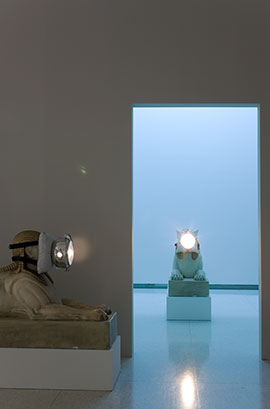
If It Need Be Termed Surrender: Trisha Donnelly’s Subjunctive Case
By Michael Jay McClure
Allow for a problem within contemporary art, a problem concerning emptiness. After experiencing and writing on installations that, say, immersed me in cave systems, faux-hospitals, or forests, after navigating landscapes of fur or video labyrinths, I found myself, often, elsewhere. A group of contemporary installations seemed overwhelmingly spare, a few small objects, and I began to wonder what such a shift of spatial tenancy meant.

If It Need Be Termed Surrender: Trisha Donnelly’s Subjunctive Case
By Michael Jay McClure
Allow for a problem within contemporary art, a problem concerning emptiness. After experiencing and writing on installations that, say, immersed me in cave systems, faux-hospitals, or forests, after navigating landscapes of fur or video labyrinths, I found myself, often, elsewhere. A group of contemporary installations seemed overwhelmingly spare, a few small objects, and I began to wonder what such a shift of spatial tenancy meant.
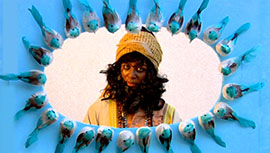
Precarious Symbolism: When the Political Sphere Overshadows Art History
By Maymanah Farha
As the methodical beat of a handheld drum begins to pound, a bearded, turbaned figure is shown lying on a bare floor. Overcome by emotional agony, he moves as though waking from a trance. A mane of dark hair frames his painted face as the camera zooms in and his melodic eulogy to lost love commences.

Precarious Symbolism: When the Political Sphere Overshadows Art History
By Maymanah Farha
As the methodical beat of a handheld drum begins to pound, a bearded, turbaned figure is shown lying on a bare floor. Overcome by emotional agony, he moves as though waking from a trance. A mane of dark hair frames his painted face as the camera zooms in and his melodic eulogy to lost love commences.
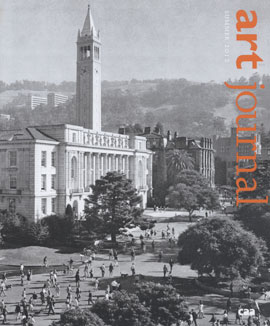
Summer 2012, Vol. 71, No. 2
In This Issue Katy Siegel, What are you working on?, 5 Artist’s Project Lorraine O’Grady, This Will Have Been: My 1980s, 6 Features Kate Mondloch, The Difference Problem: Art History and the Critical Legacy of 1980s Theoretical Feminism, 18 Alex

Summer 2012, Vol. 71, No. 2
In This Issue Katy Siegel, What are you working on?, 5 Artist’s Project Lorraine O’Grady, This Will Have Been: My 1980s, 6 Features Kate Mondloch, The Difference Problem: Art History and the Critical Legacy of 1980s Theoretical Feminism, 18 Alex

Spring 2012, Vol. 71, No. 1
In This Issue Katy Siegel, Art, History, and Criticicsm, 5 Artist’s Project Allen Ruppersberg, PST: Before and After Features Andrew Perchuk, Thomas Crow, and Howard Singerman, Pacific Standard Time: A Preliminary Conversation, 8 Connie Butler, This is Art–These People Are

Spring 2012, Vol. 71, No. 1
In This Issue Katy Siegel, Art, History, and Criticicsm, 5 Artist’s Project Allen Ruppersberg, PST: Before and After Features Andrew Perchuk, Thomas Crow, and Howard Singerman, Pacific Standard Time: A Preliminary Conversation, 8 Connie Butler, This is Art–These People Are
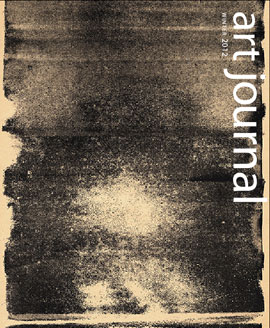
Shaping the Glass
By Katy Siegel
Life is not an idea, but ideas are part of life. Thinking is the only way out of our enmities and miseries. Vision—seeing better and more freshly, with less habit and personal bias—awakens us to life.

Shaping the Glass
By Katy Siegel
Life is not an idea, but ideas are part of life. Thinking is the only way out of our enmities and miseries. Vision—seeing better and more freshly, with less habit and personal bias—awakens us to life.
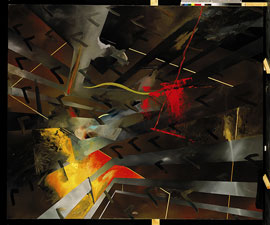
Richter’s Willkür
By Christine Mehring
Following on the heels of his signature photorealist blurs, Gerhard Richter’s abstract paintings have long exemplified a “permanent break in style as principle of style,” as Klaus Honnef noted in the artist’s first retrospective catalogue in 1969.

Richter’s Willkür
By Christine Mehring
Following on the heels of his signature photorealist blurs, Gerhard Richter’s abstract paintings have long exemplified a “permanent break in style as principle of style,” as Klaus Honnef noted in the artist’s first retrospective catalogue in 1969.

Zero at the Bone: Louise Fishman Speaks with Carrie Moyer
By Louise Fishman and Carrie Moyer
This all came to me in the last couple of weeks. In the late 1980s, early 1990s, my partner and I had gone to Madrid to see the big Velázquez retrospective. I’d never been to the Prado. I spent a lot of time looking at the Velázquez and wandering around the museum. Eventually I found Goya’s Black Paintings.

Zero at the Bone: Louise Fishman Speaks with Carrie Moyer
By Louise Fishman and Carrie Moyer
This all came to me in the last couple of weeks. In the late 1980s, early 1990s, my partner and I had gone to Madrid to see the big Velázquez retrospective. I’d never been to the Prado. I spent a lot of time looking at the Velázquez and wandering around the museum. Eventually I found Goya’s Black Paintings.

The Terms of Craft and Other Means of Making: Lee Bontecou’s Hybrid Trajectory
By Elyse Speaks
In 1958 Lee Bontecou began experimenting with a technique for making sculpture based on binding fabric to thin steel frames or armatures. Executed first on a small scale that oscillated between the form of the model and the form of tabletop sculpture, the works were emphatic in their distance from the shape and tenor of the dominant field of welded metal sculpture.

The Terms of Craft and Other Means of Making: Lee Bontecou’s Hybrid Trajectory
By Elyse Speaks
In 1958 Lee Bontecou began experimenting with a technique for making sculpture based on binding fabric to thin steel frames or armatures. Executed first on a small scale that oscillated between the form of the model and the form of tabletop sculpture, the works were emphatic in their distance from the shape and tenor of the dominant field of welded metal sculpture.

Shame: The One That Got Away
By Josephine Halvorson
The nineteenth-century painter Samuel Palmer lived within two hundred yards of the cemetery, making drawings, notes, and paintings in what he called the Valley of Visions in an effort to “bring up a mystic glimmer.” Sinclair, London Orbital Acid rain has eroded the words. Lichens, like Van Gogh blooms in orange and yellow, cling to the mauve stone.

Shame: The One That Got Away
By Josephine Halvorson
The nineteenth-century painter Samuel Palmer lived within two hundred yards of the cemetery, making drawings, notes, and paintings in what he called the Valley of Visions in an effort to “bring up a mystic glimmer.” Sinclair, London Orbital Acid rain has eroded the words. Lichens, like Van Gogh blooms in orange and yellow, cling to the mauve stone.
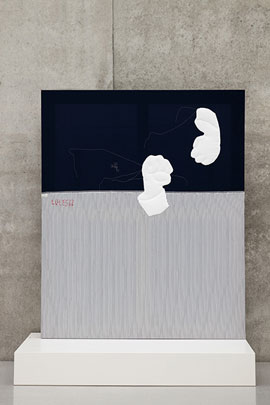
Ground Control: Painting in the Work of Cosima von Bonin
By Gregory H. Williams
During the past decade a steady flow of critical writing on contemporary painting has appeared, much of it seeking to define changes to the practice that have taken place since 1990. In several often-cited essays, a shared theme has emerged in which late-twentieth-century painting is described as undergoing a crisis of containment.

Ground Control: Painting in the Work of Cosima von Bonin
By Gregory H. Williams
During the past decade a steady flow of critical writing on contemporary painting has appeared, much of it seeking to define changes to the practice that have taken place since 1990. In several often-cited essays, a shared theme has emerged in which late-twentieth-century painting is described as undergoing a crisis of containment.

Pigment vs. Pixel: Painting in an Era of Light-Based Images
By Luke Smythe
Copied from a small and fuzzy photograph clipped from a newspaper in 2003, Gerhard Richter’s Silikat paintings depict a honeycomb array of silicate particles, modeled on the structure of a butterfly wing.

Pigment vs. Pixel: Painting in an Era of Light-Based Images
By Luke Smythe
Copied from a small and fuzzy photograph clipped from a newspaper in 2003, Gerhard Richter’s Silikat paintings depict a honeycomb array of silicate particles, modeled on the structure of a butterfly wing.
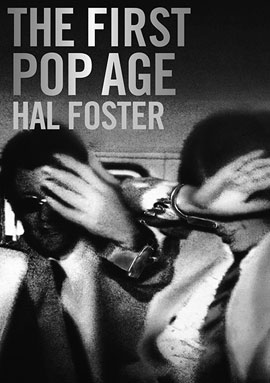
We Are Pop People
By Joshua Shannon
Anyone seeking a crisp argument for the importance of contemporary art history should welcome the introduction of Hal Foster’s latest book, The First Pop Age. Foster justifies his careful look back at five key Pop artists by persuasively arguing that their work reveals and investigates a new stage, ascendant in the early 1960s, in the history of capitalist culture.

We Are Pop People
By Joshua Shannon
Anyone seeking a crisp argument for the importance of contemporary art history should welcome the introduction of Hal Foster’s latest book, The First Pop Age. Foster justifies his careful look back at five key Pop artists by persuasively arguing that their work reveals and investigates a new stage, ascendant in the early 1960s, in the history of capitalist culture.
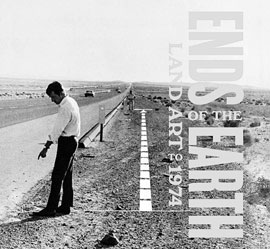
This Land Is Their Land
By Suzaan Boettger
Ends of the Earth: Land Art to 1974, the bold title of the exhibition and catalogue organized by the Museum of Contemporary Art, Los Angeles, and on view there in 2012 and later at Munich’s Haus der Kunst, evokes the grand ambitions of artists’ environmental imaginations in the early 1970s.

This Land Is Their Land
By Suzaan Boettger
Ends of the Earth: Land Art to 1974, the bold title of the exhibition and catalogue organized by the Museum of Contemporary Art, Los Angeles, and on view there in 2012 and later at Munich’s Haus der Kunst, evokes the grand ambitions of artists’ environmental imaginations in the early 1970s.

Lights, Camera, Action!
By Mechtild Widrich
Should we judge a book by its cover? The image on the front of the massive new publication on a taboo-breaking group of Austrian postwar artists shows a crowd of people gazing, some with obvious disapproval, into the camera. Among them we see policemen —something has happened or is about to, a crime perhaps—but we cannot see what has given rise to the incident.

Lights, Camera, Action!
By Mechtild Widrich
Should we judge a book by its cover? The image on the front of the massive new publication on a taboo-breaking group of Austrian postwar artists shows a crowd of people gazing, some with obvious disapproval, into the camera. Among them we see policemen —something has happened or is about to, a crime perhaps—but we cannot see what has given rise to the incident.
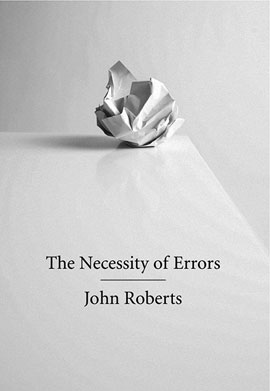
Reign of Error
By Barry Schwabsky
John Roberts is one of the more original and independent thinkers among contemporary art historians, and his wide-ranging reflections often take him well outside the boundaries of the discipline. In fact, he sometimes seems at pains to obscure what might be called the art-historical use-value of his work in order to underline its broader implications; he prefers to be seen, it appears, as a sort of unlicensed philosopher.

Reign of Error
By Barry Schwabsky
John Roberts is one of the more original and independent thinkers among contemporary art historians, and his wide-ranging reflections often take him well outside the boundaries of the discipline. In fact, he sometimes seems at pains to obscure what might be called the art-historical use-value of his work in order to underline its broader implications; he prefers to be seen, it appears, as a sort of unlicensed philosopher.
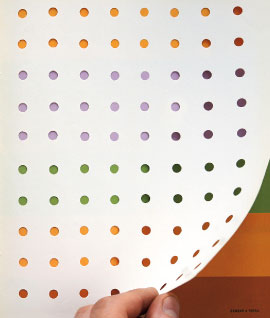
Attention Deficit
By Katy Siegel
Perhaps minor among reasons to celebrate the fact that the world did not end as predicted on 12.12.12 is that Art Journal is a little behind in its publication schedule.

Attention Deficit
By Katy Siegel
Perhaps minor among reasons to celebrate the fact that the world did not end as predicted on 12.12.12 is that Art Journal is a little behind in its publication schedule.

Planet of the Apes: John Szarkowski, My Lai, and The Animals
By Chris Balaschak
In 1969 Winogrand published The Animals alongside an exhibition of the same name at the Museum of Modern Art, New York (MoMA). Though it has never been seen as such, it was a timely project, and represents a satire of American society during the height of a war “unassimilable” by popular culture.

Planet of the Apes: John Szarkowski, My Lai, and The Animals
By Chris Balaschak
In 1969 Winogrand published The Animals alongside an exhibition of the same name at the Museum of Modern Art, New York (MoMA). Though it has never been seen as such, it was a timely project, and represents a satire of American society during the height of a war “unassimilable” by popular culture.
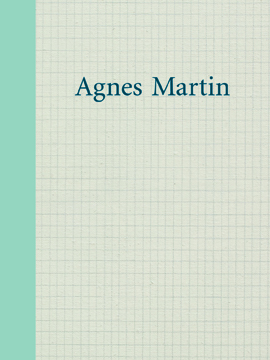
Agnes Martin, Under New Auspices
By Karen L. Schiff
Finally—a book of criticism about Agnes Martin. No other book of writing about this singular, revered artist has been in print for many years. And though Martin (1912–2004) has been an esteemed presence in the art world since at least the early 1960s, there exists no monograph, no biography, no previous collection of criticism.

Agnes Martin, Under New Auspices
By Karen L. Schiff
Finally—a book of criticism about Agnes Martin. No other book of writing about this singular, revered artist has been in print for many years. And though Martin (1912–2004) has been an esteemed presence in the art world since at least the early 1960s, there exists no monograph, no biography, no previous collection of criticism.

What Are You Working On?
By Katy Siegel
This issue of Art Journal comes after two issues that tightly revolved around a single concept: the medium of print (Winter 2011) and the Pacific Standard Time initiative (Spring 2012).

What Are You Working On?
By Katy Siegel
This issue of Art Journal comes after two issues that tightly revolved around a single concept: the medium of print (Winter 2011) and the Pacific Standard Time initiative (Spring 2012).
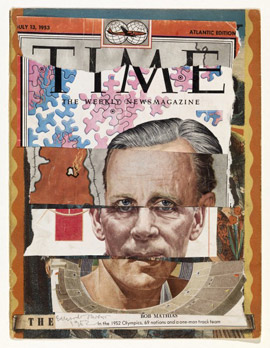
Another Time
By Alex Kitnick
Sometime in the early 1950s, the artist Eduardo Paolozzi began making collages from the covers of Time magazine, cutting them up and putting them back together again in new ways.

Another Time
By Alex Kitnick
Sometime in the early 1950s, the artist Eduardo Paolozzi began making collages from the covers of Time magazine, cutting them up and putting them back together again in new ways.
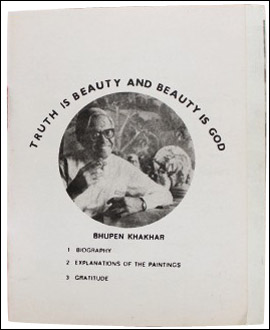
Bhupen Khakhar’s “Pop” in India, 1970-72
Bhupen Khakhar self-produced a catalogue to accompany his March 1972 exhibition Truth Is Beauty and Beauty Is God at Gallery Chemould in Bombay. It is reproduced here, in its entirety.

Bhupen Khakhar’s “Pop” in India, 1970-72
Bhupen Khakhar self-produced a catalogue to accompany his March 1972 exhibition Truth Is Beauty and Beauty Is God at Gallery Chemould in Bombay. It is reproduced here, in its entirety.

Invisible Products
Julia Bryan-Wilson’s essay “Invisible Products” explores a most unusual archive of photographs by Ansel Adams—some seven thousand photographs he took in the mid-1960s on commission from the University of California.

Invisible Products
Julia Bryan-Wilson’s essay “Invisible Products” explores a most unusual archive of photographs by Ansel Adams—some seven thousand photographs he took in the mid-1960s on commission from the University of California.

New Realisms in the 1960s
By Jaimey Hamilton
The term nouveau réalisme, or new realism, has long been tied to the specific claims made by the critic Pierre Restany about the Paris-based art group he promoted. Restany convinced Arman, Yves Klein, Jean Tinguely, Daniel Spoerri, Martial Raysse, Jacques de la Villeglé, Raymond Hains, and François Dufrêne to sign on initially, and then added César, Niki de Saint-Phalle, Gérard Deschamps, Mimmo Rotella, and Christo.

New Realisms in the 1960s
By Jaimey Hamilton
The term nouveau réalisme, or new realism, has long been tied to the specific claims made by the critic Pierre Restany about the Paris-based art group he promoted. Restany convinced Arman, Yves Klein, Jean Tinguely, Daniel Spoerri, Martial Raysse, Jacques de la Villeglé, Raymond Hains, and François Dufrêne to sign on initially, and then added César, Niki de Saint-Phalle, Gérard Deschamps, Mimmo Rotella, and Christo.

Art, History, and Criticism
By Katy Siegel
It can seem as if recent changes in how we learn do little more than facilitate a quantitative randomness. But the centrality of the Internet to intellectual work has made visible one under-recognized and revolutionary truth: the collective nature of creating knowledge.

Art, History, and Criticism
By Katy Siegel
It can seem as if recent changes in how we learn do little more than facilitate a quantitative randomness. But the centrality of the Internet to intellectual work has made visible one under-recognized and revolutionary truth: the collective nature of creating knowledge.

City after Fifty Years’ Living: L.A.’s Differences in Relation
By Malik Gaines
A marketing triumph, Pacific Standard Time has been responsible for a series of promotional videos, slickly produced, that pair an honored artist with a Southern California celebrity. The shining success among these original works is the pairing of the late design team Ray and Charles Eames with the rapper and actor Ice Cube.

City after Fifty Years’ Living: L.A.’s Differences in Relation
By Malik Gaines
A marketing triumph, Pacific Standard Time has been responsible for a series of promotional videos, slickly produced, that pair an honored artist with a Southern California celebrity. The shining success among these original works is the pairing of the late design team Ray and Charles Eames with the rapper and actor Ice Cube.
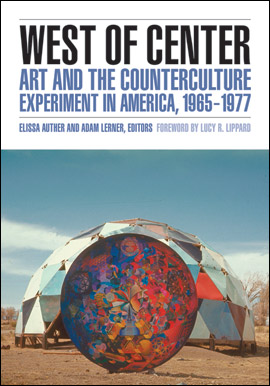
City of Angles
By Jennifer Doyle
Los Angeles mythology is hard to cut through: The city has no center, no sense of history, it has no depth. It is the city that plays itself and the city that forgets itself.

City of Angles
By Jennifer Doyle
Los Angeles mythology is hard to cut through: The city has no center, no sense of history, it has no depth. It is the city that plays itself and the city that forgets itself.
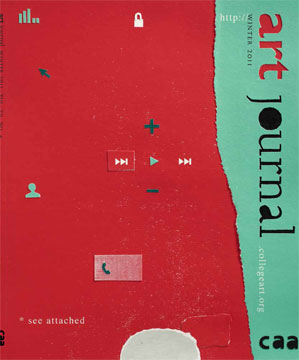
Winter 2011, Vol. 70, No. 4
In This Issue Katy Siegel, In Print, 5 Artist’s Project Matthew Brannon, Pressing the “Delete” button, not pressing the “Are you sure you want to delete?” button, covers Centennial Essay Sarah Suzuki, Print People: A Brief Taxonomy of Contemporary Printmaking, 6

Winter 2011, Vol. 70, No. 4
In This Issue Katy Siegel, In Print, 5 Artist’s Project Matthew Brannon, Pressing the “Delete” button, not pressing the “Are you sure you want to delete?” button, covers Centennial Essay Sarah Suzuki, Print People: A Brief Taxonomy of Contemporary Printmaking, 6

Fall 2011, Vol. 70, No. 3
In This Issue Katy Siegel, Reconstruction, 5 Centennial Essay Krista Thompson, A Sidelong Glance: The Practice of African Diaspora Art History in the United States, 6 Forum: Performance, Live or Dead Amelia Jones, Introduction, 32 Ron Athey, Getting It Right

Fall 2011, Vol. 70, No. 3
In This Issue Katy Siegel, Reconstruction, 5 Centennial Essay Krista Thompson, A Sidelong Glance: The Practice of African Diaspora Art History in the United States, 6 Forum: Performance, Live or Dead Amelia Jones, Introduction, 32 Ron Athey, Getting It Right

Summer 2011, Vol. 70, No. 2
In This Issue Katy Siegel, Making Time, 5 Centennial Essay Nora A. Taylor, Art without History? Southeast Asian Artists and Their Communities in the Face of Geography, 6 Free Time Joe Scanlan Free Time: An Introduction, 24 Dexter Sinister, A Note

Summer 2011, Vol. 70, No. 2
In This Issue Katy Siegel, Making Time, 5 Centennial Essay Nora A. Taylor, Art without History? Southeast Asian Artists and Their Communities in the Face of Geography, 6 Free Time Joe Scanlan Free Time: An Introduction, 24 Dexter Sinister, A Note
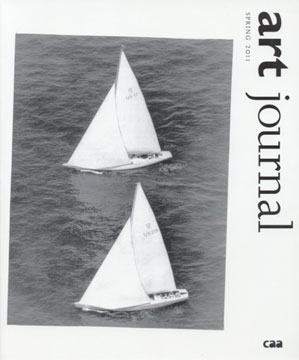
Spring 2011, Vol. 70, No. 1
In This Issue Katy Siegel, Race to the Finish, 5 Artist’s Project Paul Sietsema, covers Centennial Essay Richard Shiff, Every Shiny Object Wants an Infant Who Will Love It, 6 Features Saloni Mathur, Charles and Ray Eames in India, 34

Spring 2011, Vol. 70, No. 1
In This Issue Katy Siegel, Race to the Finish, 5 Artist’s Project Paul Sietsema, covers Centennial Essay Richard Shiff, Every Shiny Object Wants an Infant Who Will Love It, 6 Features Saloni Mathur, Charles and Ray Eames in India, 34
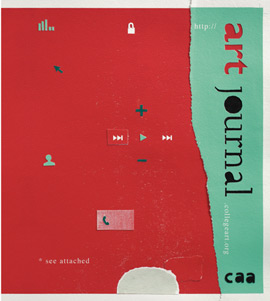
In Print
By Katy Siegel
At my first meeting as editor-in-chief, the Art Journal Editorial Board learned that due to fallout from the financial crisis of 2008–9, CAA could not afford to publish the journal as a quarterly—there would only be three issues in 2010, with reduced color and page count. It turns out that printing a magazine is, as these things go, a luxury.

In Print
By Katy Siegel
At my first meeting as editor-in-chief, the Art Journal Editorial Board learned that due to fallout from the financial crisis of 2008–9, CAA could not afford to publish the journal as a quarterly—there would only be three issues in 2010, with reduced color and page count. It turns out that printing a magazine is, as these things go, a luxury.
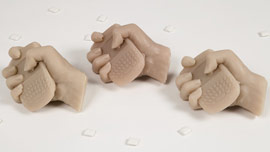
The Binder and the Server
By Triple Canopy
At first a convenience, then quickly a conundrum: Of course we would publish on the internet. We came of age with the medium, it was our generation’s default. Plus, financially speaking, it remained—and remains, for now—a wheat-paste endeavor: nine dollars a month to hold down a domain name.

The Binder and the Server
By Triple Canopy
At first a convenience, then quickly a conundrum: Of course we would publish on the internet. We came of age with the medium, it was our generation’s default. Plus, financially speaking, it remained—and remains, for now—a wheat-paste endeavor: nine dollars a month to hold down a domain name.

Fête in Venice
By Seth McCormick
Hiroko Ikegami’s The Great Migrator, which toward the end quotes Homi Bhabha on the subjects of postcolonial mimicry and hybridization, is itself something of a hybrid: part traditional monograph, part Foucauldian genealogy of contemporary art in the age of globalization.

Fête in Venice
By Seth McCormick
Hiroko Ikegami’s The Great Migrator, which toward the end quotes Homi Bhabha on the subjects of postcolonial mimicry and hybridization, is itself something of a hybrid: part traditional monograph, part Foucauldian genealogy of contemporary art in the age of globalization.

Reconstruction
By Katy Siegel
For several days in 2000, William Pope.L sat enthroned on a towering toilet, contemplating and quite literally consuming The Wall Street Journal, dusted with white powder and surrounded by the great American fluids—milk and ketchup. This performance grew from an earlier 1991 version, staged on the street, and the artist has reenacted the performance several times since, most recently at the New Museum in New York in 2010.

Reconstruction
By Katy Siegel
For several days in 2000, William Pope.L sat enthroned on a towering toilet, contemplating and quite literally consuming The Wall Street Journal, dusted with white powder and surrounded by the great American fluids—milk and ketchup. This performance grew from an earlier 1991 version, staged on the street, and the artist has reenacted the performance several times since, most recently at the New Museum in New York in 2010.
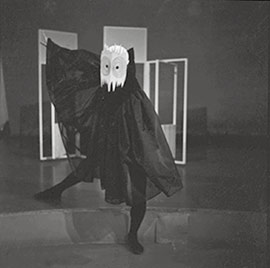
Experimentation and Tradition: The Avant-Garde Play Pierrot Lunaire by Jikken Kōbō and Takechi Tetsuji
By Miwako Tezuka
During the 1950s, after the devastating defeat in World War II, Japan exerted itself to regain political and economic confidence. Arts and culture played a key role in the country’s recovery: the image of a belligerent nation in the recent past needed to be replaced by a new impression of Japan as a peaceful nation of culture; the people were yearning for a return of their cultural life, or simply, entertainments; and, released from the straitjacket that suppressed free expression, artists quickly resumed their creative activities.

Experimentation and Tradition: The Avant-Garde Play Pierrot Lunaire by Jikken Kōbō and Takechi Tetsuji
By Miwako Tezuka
During the 1950s, after the devastating defeat in World War II, Japan exerted itself to regain political and economic confidence. Arts and culture played a key role in the country’s recovery: the image of a belligerent nation in the recent past needed to be replaced by a new impression of Japan as a peaceful nation of culture; the people were yearning for a return of their cultural life, or simply, entertainments; and, released from the straitjacket that suppressed free expression, artists quickly resumed their creative activities.

Take It to the Air: Radio as Public Art
First staged in the main railroad station in Hamburg in 2002, the Leipzig version of Radio Ballet was performed the following year. Subtitled “Übung in nichtbestimmungsgemäßem Verweilen,” or “Exercise in Lingering Not According to the Rules,” the piece gathered people in the Leipzig station for a group radio listening experience.

Take It to the Air: Radio as Public Art
First staged in the main railroad station in Hamburg in 2002, the Leipzig version of Radio Ballet was performed the following year. Subtitled “Übung in nichtbestimmungsgemäßem Verweilen,” or “Exercise in Lingering Not According to the Rules,” the piece gathered people in the Leipzig station for a group radio listening experience.
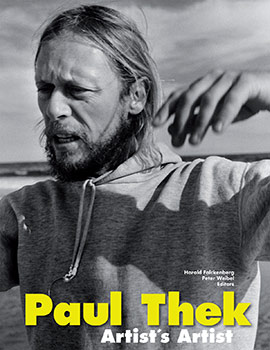
Thek’s “As If”
By Robert Slifkin
Roland Barthes’s pithy thesis from his seminal essay “The Reality Effect” (1968) reveals what might be called the vitalist basis of modernist indeterminacy.

Thek’s “As If”
By Robert Slifkin
Roland Barthes’s pithy thesis from his seminal essay “The Reality Effect” (1968) reveals what might be called the vitalist basis of modernist indeterminacy.
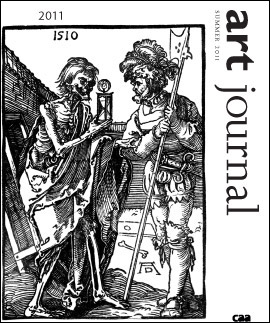
Making Time
Time is passing quickly; as I write this, I realize that I am more than halfway through my tenure as editor-in-chief of Art Journal.

Making Time
Time is passing quickly; as I write this, I realize that I am more than halfway through my tenure as editor-in-chief of Art Journal.

Art & Soul: An Experimental Friendship between the Street and a Museum
By Rebecca Zorach
In the summer of 1968, as the Democratic National Committee prepared to roll into Chicago, the city’s Museum of Contemporary Art was entering into an unusual partnership—an “experimental friendship”—with an organization called CVL, Inc. What’s remarkable about this organization was that it was the new incarnation of a notorious street gang known as the Vice Lords.

Art & Soul: An Experimental Friendship between the Street and a Museum
By Rebecca Zorach
In the summer of 1968, as the Democratic National Committee prepared to roll into Chicago, the city’s Museum of Contemporary Art was entering into an unusual partnership—an “experimental friendship”—with an organization called CVL, Inc. What’s remarkable about this organization was that it was the new incarnation of a notorious street gang known as the Vice Lords.
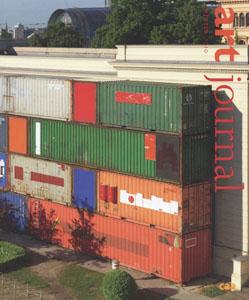
Winter 2010, Vol. 69, No. 4
In This Issue Katy Siegel, Something Totally Unpredictable, 5 Features Kerry James Marshall, Adrift, Infinity, or Oblivion, from Dailies, Inside Cover Kelly Baum, Santiago Sierra: How to Do Things with Words, 6 Forum: Land Use in Contemporary Art Kirsten Swenson,

Winter 2010, Vol. 69, No. 4
In This Issue Katy Siegel, Something Totally Unpredictable, 5 Features Kerry James Marshall, Adrift, Infinity, or Oblivion, from Dailies, Inside Cover Kelly Baum, Santiago Sierra: How to Do Things with Words, 6 Forum: Land Use in Contemporary Art Kirsten Swenson,
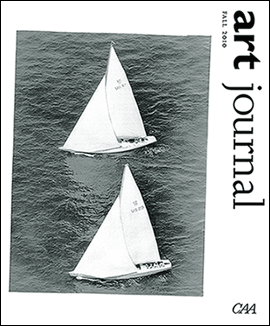
Race to the Finish
By Katy Siegel
This is the first issue of Art Journal published in 2011, CAA’s Centennial year. We will mark the occasion throughout the year, helped by scholars and artists and a grant from the Andy Warhol Foundation. Our website launched in February, in response to the changing nature of art writing and publishing, and to the wish to attend to time-based and new media art.

Race to the Finish
By Katy Siegel
This is the first issue of Art Journal published in 2011, CAA’s Centennial year. We will mark the occasion throughout the year, helped by scholars and artists and a grant from the Andy Warhol Foundation. Our website launched in February, in response to the changing nature of art writing and publishing, and to the wish to attend to time-based and new media art.
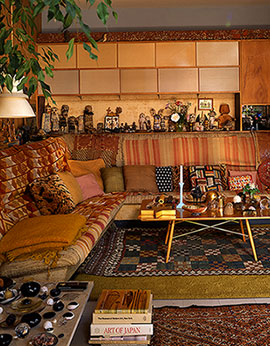
Charles and Ray Eames in India
By Saloni Mathur
A photograph of the living room of the Eames house in the Pacific Palisades neighborhood of Los Angeles has proven rather puzzling to historians of design. It depicts the famous Case Study House as full of exotic collectibles. Hopi kachina dolls, seashells, craft objects, silk textiles from Nepal and Thailand, and elaborately patterned rugs from Mexico and India all crowd and assault their modernist frame.

Charles and Ray Eames in India
By Saloni Mathur
A photograph of the living room of the Eames house in the Pacific Palisades neighborhood of Los Angeles has proven rather puzzling to historians of design. It depicts the famous Case Study House as full of exotic collectibles. Hopi kachina dolls, seashells, craft objects, silk textiles from Nepal and Thailand, and elaborately patterned rugs from Mexico and India all crowd and assault their modernist frame.

City of Degenerate Angels: Wallace Berman, Jazz and Semina in Postwar Los Angeles
Ken D. Allan introduces two videos related to “City of Degenerate Angels: Wallace Berman, Jazz and Semina in Postwar Los Angeles,” his contribution to the Spring 2011 issue of Art Journal.

City of Degenerate Angels: Wallace Berman, Jazz and Semina in Postwar Los Angeles
Ken D. Allan introduces two videos related to “City of Degenerate Angels: Wallace Berman, Jazz and Semina in Postwar Los Angeles,” his contribution to the Spring 2011 issue of Art Journal.

The Poverty of Poetry
Julia Bryan-Wilson, Art Workers: Radical Practice in the Vietnam War Era
By Michael Corris
The Art Workers’ Coalition (AWC) was formed in New York in 1969 in the wake of an incident in a museum. The Museum of Modern Art, New York (MoMA), mounted an exhibition titled The Machine as Seen at the End of the Mechanical Age. Within the exhibition was a work by the artist Vassilakis Takis.

The Poverty of Poetry
Julia Bryan-Wilson, Art Workers: Radical Practice in the Vietnam War Era
By Michael Corris
The Art Workers’ Coalition (AWC) was formed in New York in 1969 in the wake of an incident in a museum. The Museum of Modern Art, New York (MoMA), mounted an exhibition titled The Machine as Seen at the End of the Mechanical Age. Within the exhibition was a work by the artist Vassilakis Takis.
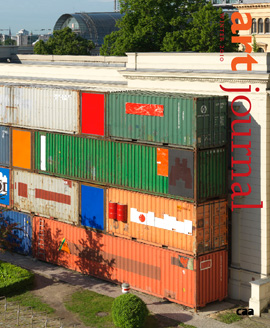
Something Totally Unpredictable
By Katy Siegel
The Art Journal Award, CAA’s annual prize for the best article published in the magazine, has been awarded to the current issue’s feature on Land art, a group of essays collected and introduced by Kirsten Swenson.

Something Totally Unpredictable
By Katy Siegel
The Art Journal Award, CAA’s annual prize for the best article published in the magazine, has been awarded to the current issue’s feature on Land art, a group of essays collected and introduced by Kirsten Swenson.
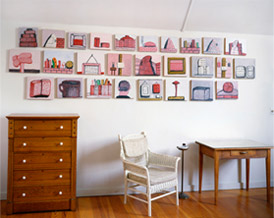
Soul-Beating
By David Reed
I was a student at the New York Studio School during the fall of 1966 and spring of 1967. The school was then located in a loft building on the northeast corner of Broadway and Bleecker Street. Draft deferments during the Vietnam War were not granted to students attending an art school, especially an unaccredited one like the Studio School.

Soul-Beating
By David Reed
I was a student at the New York Studio School during the fall of 1966 and spring of 1967. The school was then located in a loft building on the northeast corner of Broadway and Bleecker Street. Draft deferments during the Vietnam War were not granted to students attending an art school, especially an unaccredited one like the Studio School.
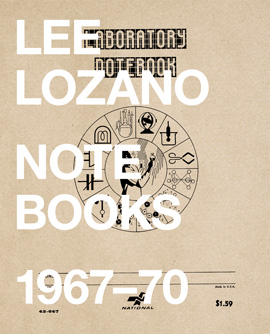
Lee Lozano, Lee Lozano: Notebooks 1967–70
By Lauren O’Neill-Butler
“HISTORY DRAGS.” Of the many shrewd observations and witticisms that Lee Lozano (1930–1999) recorded in her notebooks, this one strikes deepest when considering the revival of interest in her work. Of course, we’ll never know her opinion on the widespread, international attention that has been lavished on her art and life over the last decade.

Lee Lozano, Lee Lozano: Notebooks 1967–70
By Lauren O’Neill-Butler
“HISTORY DRAGS.” Of the many shrewd observations and witticisms that Lee Lozano (1930–1999) recorded in her notebooks, this one strikes deepest when considering the revival of interest in her work. Of course, we’ll never know her opinion on the widespread, international attention that has been lavished on her art and life over the last decade.

Winter 1998, Vol. 57, No. 4
Features Vera Frenkel with Dot Tuer and Clive Robertson, The Story Is Always Partial: A Conversation with Vera Frenkel, 2 Michael Brenson, The Curator’s Moment, 16 Mónica Amor, Okwui Enwezor, Gao Minglu, Oscar Ho, Kobena Mercer, Irit Rogoff, Liminalities: Discussions

Winter 1998, Vol. 57, No. 4
Features Vera Frenkel with Dot Tuer and Clive Robertson, The Story Is Always Partial: A Conversation with Vera Frenkel, 2 Michael Brenson, The Curator’s Moment, 16 Mónica Amor, Okwui Enwezor, Gao Minglu, Oscar Ho, Kobena Mercer, Irit Rogoff, Liminalities: Discussions
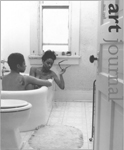
Fall 1998, Vol. 57, No. 3
Race and Visual Representation Guest edited by James Smalls and Judith Wilson; portfolio selected by Kenseth Armstead James Smalls, Visualizing Race: A Lifelong Process and Training, 2 Kenseth Armstead, Surface Tensions, 4 Eduardo de Jesús Douglas, The Colonial Self: Homosexuality

Fall 1998, Vol. 57, No. 3
Race and Visual Representation Guest edited by James Smalls and Judith Wilson; portfolio selected by Kenseth Armstead James Smalls, Visualizing Race: A Lifelong Process and Training, 2 Kenseth Armstead, Surface Tensions, 4 Eduardo de Jesús Douglas, The Colonial Self: Homosexuality
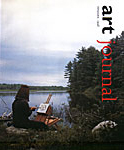
Summer 1998, Vol. 57, No. 2
From the Editorial Board, 2 Conversation Janet A. Kaplan, The Quiet in the Land: Everyday Life, Contemporary Art, and the Shakers: A Conversation with Janet A. Kaplan, 5 Features Doug Ashford, The Exhibition as an Artistic Medium, 28 Christina Hill’s

Summer 1998, Vol. 57, No. 2
From the Editorial Board, 2 Conversation Janet A. Kaplan, The Quiet in the Land: Everyday Life, Contemporary Art, and the Shakers: A Conversation with Janet A. Kaplan, 5 Features Doug Ashford, The Exhibition as an Artistic Medium, 28 Christina Hill’s

Spring 1998, Vol. 57, No. 1
The Reception of Christian Devotional Art Editor’s Statement Pamela M. Jones, The Reception of Christian Devotional Art: The Renaissance to the Present, 2 Articles Roger J. Crum, Facing the Closed Doors to Reception? Speculations on Foreign Exchange, Liturgical Difference, and

Spring 1998, Vol. 57, No. 1
The Reception of Christian Devotional Art Editor’s Statement Pamela M. Jones, The Reception of Christian Devotional Art: The Renaissance to the Present, 2 Articles Roger J. Crum, Facing the Closed Doors to Reception? Speculations on Foreign Exchange, Liturgical Difference, and

Winter 1999, Vol. 58, No. 4
In This Issue Janet A. Kaplan, 3 Responses Vasif Kortun and Judith Mastai, 4 Benefit Print Maura Reilly, Notes on Kiki Smiths Fall/Winter, 6 Features Mira Schor, Contemporary Feminism: Art Practice, Theory, and ActivismAn Intergenerational Perspective (Emma Amos, Susan Bee,

Winter 1999, Vol. 58, No. 4
In This Issue Janet A. Kaplan, 3 Responses Vasif Kortun and Judith Mastai, 4 Benefit Print Maura Reilly, Notes on Kiki Smiths Fall/Winter, 6 Features Mira Schor, Contemporary Feminism: Art Practice, Theory, and ActivismAn Intergenerational Perspective (Emma Amos, Susan Bee,
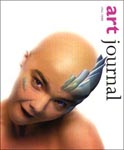
Fall 1999, Vol. 58, No. 3
In This Issue Janet A. Kaplan, On Translation, 3 Responses Patricia Phillips and Maxine Payne Caulfield, 4 Contemporary Indian Art Guest edited by Andrew L. Cohen and Marcella C. Sirhandi Guest Editors’ Statements, 7 Andrew L. Cohenm, Contemporary Indian Painting:

Fall 1999, Vol. 58, No. 3
In This Issue Janet A. Kaplan, On Translation, 3 Responses Patricia Phillips and Maxine Payne Caulfield, 4 Contemporary Indian Art Guest edited by Andrew L. Cohen and Marcella C. Sirhandi Guest Editors’ Statements, 7 Andrew L. Cohenm, Contemporary Indian Painting:
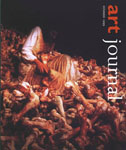
Summer 1999, Vol. 58, No. 2
In This Issue John Alan Farmer, 3 Responses Russell Ferguson and Naomi Sawelson-Gorse, 4 Features Janet A. Kaplan, Deeper and Deeper: Interview with Marina Abramovic, 6 Carol Becker, The Romance of Nomadism: A Series of Reflections, 22 Olu Oguibe, Finding

Summer 1999, Vol. 58, No. 2
In This Issue John Alan Farmer, 3 Responses Russell Ferguson and Naomi Sawelson-Gorse, 4 Features Janet A. Kaplan, Deeper and Deeper: Interview with Marina Abramovic, 6 Carol Becker, The Romance of Nomadism: A Series of Reflections, 22 Olu Oguibe, Finding
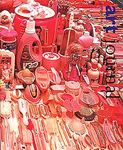
Spring 1999, Vol. 58, No. 1
Rethinking Studio Art Education Guest edited by Pamela Wye Program-Wide Initiatives Kate Morrison Catterall and Helen Maria Nugent, W.A.R.P.: A Radical Solution to Teaching Foundations, 4 Carol Becker, The Art of Crossing the Street, 10 G. Roy Levin, Art Education

Spring 1999, Vol. 58, No. 1
Rethinking Studio Art Education Guest edited by Pamela Wye Program-Wide Initiatives Kate Morrison Catterall and Helen Maria Nugent, W.A.R.P.: A Radical Solution to Teaching Foundations, 4 Carol Becker, The Art of Crossing the Street, 10 G. Roy Levin, Art Education
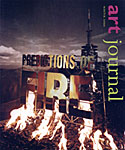
Winter 2000, Vol. 59, No. 4
In This Issue Janet A. Kaplan, 3 Responses Bradley Rubenstein, 4 Network Society Gregg Bordowitz, 5 Features Crossing Boundaries in Cyberspace? The Politics of “Body and Language” after the Emergence of New Media Guest Edited by Ursula Frohne and Christian

Winter 2000, Vol. 59, No. 4
In This Issue Janet A. Kaplan, 3 Responses Bradley Rubenstein, 4 Network Society Gregg Bordowitz, 5 Features Crossing Boundaries in Cyberspace? The Politics of “Body and Language” after the Emergence of New Media Guest Edited by Ursula Frohne and Christian
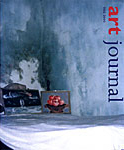
Fall 2000, Vol. 59, No. 3
In This Issue Janet A. Kaplan, 3 Features France Morin, The Quiet in the Land: Everyday Life, Contemporary Art, and Projeto Axé, 4 Moira Roth, Of Self and History: Exchanges with Linda Nochlin, 18 John Alan Farmer, Through the Labyrinth:

Fall 2000, Vol. 59, No. 3
In This Issue Janet A. Kaplan, 3 Features France Morin, The Quiet in the Land: Everyday Life, Contemporary Art, and Projeto Axé, 4 Moira Roth, Of Self and History: Exchanges with Linda Nochlin, 18 John Alan Farmer, Through the Labyrinth:
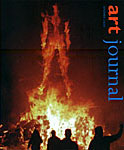
Summer 2000, Vol. 59, No. 2
In This Issue Janet A. Kaplan, 3 Responses Miriam Schapiro, 4 Conversation Janet A. Kaplan with Bracken Hendricks, Geoffrey Hendricks, Hannah Higgins, Alison Knowles, Flux Generations, 6 Features Roxana Marcoci, The Anti-Historicist Approach: Brancusi, “Our Contemporary”, 18 Charles Green, Doppelgangers

Summer 2000, Vol. 59, No. 2
In This Issue Janet A. Kaplan, 3 Responses Miriam Schapiro, 4 Conversation Janet A. Kaplan with Bracken Hendricks, Geoffrey Hendricks, Hannah Higgins, Alison Knowles, Flux Generations, 6 Features Roxana Marcoci, The Anti-Historicist Approach: Brancusi, “Our Contemporary”, 18 Charles Green, Doppelgangers
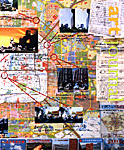
Spring 2000, Vol. 59, No. 1
In This Issue John Alan Farmer, 3 Features Valerie Cassel, France Morin, Apinan Poshyandanda, Mari Carmen Ramírez, Caroline Turner, Igor Zabel, Beyond Boundaries: Rethinking Contemporary Art Exhibitions, 4 John Alan Farmer, The Experimental Exercise of Freedom: A Conversation with Rina

Spring 2000, Vol. 59, No. 1
In This Issue John Alan Farmer, 3 Features Valerie Cassel, France Morin, Apinan Poshyandanda, Mari Carmen Ramírez, Caroline Turner, Igor Zabel, Beyond Boundaries: Rethinking Contemporary Art Exhibitions, 4 John Alan Farmer, The Experimental Exercise of Freedom: A Conversation with Rina

Winter 2001, Vol. 60, No. 4
In This Issue Janet A. Kaplan, 2 Responses Keith Townsend Obadike, 4 Features Joanna Roche, Performing Memory in Moon in a Tree: Carolee Schneemann Recollects Joseph Cornell, 6 Igor Zabel, Women in Black, 16 Laura Auricchio, Works in Translation: Ghada

Winter 2001, Vol. 60, No. 4
In This Issue Janet A. Kaplan, 2 Responses Keith Townsend Obadike, 4 Features Joanna Roche, Performing Memory in Moon in a Tree: Carolee Schneemann Recollects Joseph Cornell, 6 Igor Zabel, Women in Black, 16 Laura Auricchio, Works in Translation: Ghada

Fall 2001, Vol. 60, No. 3
In This Issue Janet A. Kaplan, Beyond Words, 3 Responses Ernesto Pujol, 4 Network Society Gregg Bordowitz, 7 Features Mary Katherine Coffey, Histories that Haunt: A Conversation with Ann Hamilton, 10 Joanna Frueh, Bloodred Beauty: A Meditation on Mel Gibson’s

Fall 2001, Vol. 60, No. 3
In This Issue Janet A. Kaplan, Beyond Words, 3 Responses Ernesto Pujol, 4 Network Society Gregg Bordowitz, 7 Features Mary Katherine Coffey, Histories that Haunt: A Conversation with Ann Hamilton, 10 Joanna Frueh, Bloodred Beauty: A Meditation on Mel Gibson’s

Summer 2001, Vol. 60, No. 2
In This Issue John Alan Farmer Responses Caroline Arscott, 4 Network Society Gregg Bordowitz, 6 Features Connie Butler, Saskia Sassen, Gavin Hipkins, Lee Weng Choy, Allan Sekula, Flight Patterns, 9 Moira Roth, Obdurate History: Dinh Q. Lê, the Vietnam War,

Summer 2001, Vol. 60, No. 2
In This Issue John Alan Farmer Responses Caroline Arscott, 4 Network Society Gregg Bordowitz, 6 Features Connie Butler, Saskia Sassen, Gavin Hipkins, Lee Weng Choy, Allan Sekula, Flight Patterns, 9 Moira Roth, Obdurate History: Dinh Q. Lê, the Vietnam War,
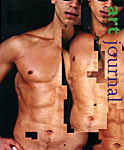
Spring 2001, Vol. 60, No. 1
In This Issue Janet A. Kaplan and John Alan Farmer, 3 Artist’s Project Ellen Rothenberg, Restless Mobility, 4 Responses Ellen K. Levy, 6 Network Society Gregg Bordowitz, 10 Features Jens Liebchen, Power Station for Art vs. Art for Power Station,

Spring 2001, Vol. 60, No. 1
In This Issue Janet A. Kaplan and John Alan Farmer, 3 Artist’s Project Ellen Rothenberg, Restless Mobility, 4 Responses Ellen K. Levy, 6 Network Society Gregg Bordowitz, 10 Features Jens Liebchen, Power Station for Art vs. Art for Power Station,

Winter 2002, Vol. 61, No. 4
In This Issue Patricia C. Phillips, At This Time, 3 Features and Artists’ Projects Kevin Chua, Simryn Gill and Migration’s Capital, 4 Alix Ohlin, Andreas Gursky and the Contemporary Sublime, 22 Martin Gantman, See you when we get home, 36

Winter 2002, Vol. 61, No. 4
In This Issue Patricia C. Phillips, At This Time, 3 Features and Artists’ Projects Kevin Chua, Simryn Gill and Migration’s Capital, 4 Alix Ohlin, Andreas Gursky and the Contemporary Sublime, 22 Martin Gantman, See you when we get home, 36
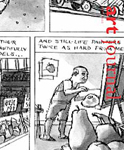
Fall 2002, Vol. 61, No. 3
In This Issue Janet A. Kaplan, 3 Artist’s Project Ben Katchor, Hotel & Farm, 4 Features Janet A. Kaplan, Johanna d’Arc of Mongolia: Interview with Ulrike Ottinger, 7 Hattie Gordon, Anne Wilson’s Feast, 23 Daniel Rosenberg, One Small Step (for

Fall 2002, Vol. 61, No. 3
In This Issue Janet A. Kaplan, 3 Artist’s Project Ben Katchor, Hotel & Farm, 4 Features Janet A. Kaplan, Johanna d’Arc of Mongolia: Interview with Ulrike Ottinger, 7 Hattie Gordon, Anne Wilson’s Feast, 23 Daniel Rosenberg, One Small Step (for
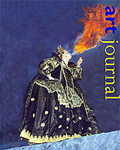
Summer 2002, Vol. 61, No. 2
In This Issue Janet A. Kaplan, 3 Artist’s Project Doug Fishbone, A Giant Pile of Bananas—Can You Dig It? Features

Summer 2002, Vol. 61, No. 2
In This Issue Janet A. Kaplan, 3 Artist’s Project Doug Fishbone, A Giant Pile of Bananas—Can You Dig It? Features
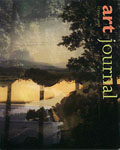
Spring 2002, Vol. 61, No. 1
In This Issue Janet A. Kaplan, 3 Features Rainer Usselmann, 18. Oktober 1977: Gerhard Richter’s Work of Mourning and Its New Audience, 4 Betti-Sue Hertz, Meltdown! What Is Left Over by Carlos Andrade and Todd Ayoung, 26 Catherine Lord, From

Spring 2002, Vol. 61, No. 1
In This Issue Janet A. Kaplan, 3 Features Rainer Usselmann, 18. Oktober 1977: Gerhard Richter’s Work of Mourning and Its New Audience, 4 Betti-Sue Hertz, Meltdown! What Is Left Over by Carlos Andrade and Todd Ayoung, 26 Catherine Lord, From
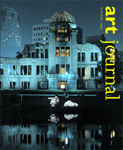
Winter 2003, Vol. 62, No. 4
In This Issue Patricia C. Phillips, Why We Should Care, 3 Forum Robin Greeley, Ancient Iraq, Contemporary Crisis, 6 Zainab Bahrani, Iraq’s Cultural Heritage: Monuments, History, and Loss, 10 Harriet Crawford, The Crumbling of an Ivory Tower, 18 John Malcolm

Winter 2003, Vol. 62, No. 4
In This Issue Patricia C. Phillips, Why We Should Care, 3 Forum Robin Greeley, Ancient Iraq, Contemporary Crisis, 6 Zainab Bahrani, Iraq’s Cultural Heritage: Monuments, History, and Loss, 10 Harriet Crawford, The Crumbling of an Ivory Tower, 18 John Malcolm

Fall 2003, Vol. 62, No. 3
In This Issue Patricia C. Phillips, Close Encounters, 3 Thematic Investigation: Photography and the Paranormal Paranormal Portfolio, 4 Mark Alice Durant, The Blur of the Otherworldly, 6 Louis Kaplan, Where the Paranoid Meets the Paranormal: Speculations on Spirit Photography, 18

Fall 2003, Vol. 62, No. 3
In This Issue Patricia C. Phillips, Close Encounters, 3 Thematic Investigation: Photography and the Paranormal Paranormal Portfolio, 4 Mark Alice Durant, The Blur of the Otherworldly, 6 Louis Kaplan, Where the Paranoid Meets the Paranormal: Speculations on Spirit Photography, 18

Summer 2003, Vol. 62, No. 2
In This Issue Patricia C. Phillips, At Last We Can No Longer Predict the Futuer 3 Features, Interviews, Conversations Antony Hudek, Excavating the Body Politic: An Interview with Conrad Atkinson, 4 Nicholas Mirzoeff, Newpapers, with a portfolio of artists’ works

Summer 2003, Vol. 62, No. 2
In This Issue Patricia C. Phillips, At Last We Can No Longer Predict the Futuer 3 Features, Interviews, Conversations Antony Hudek, Excavating the Body Politic: An Interview with Conrad Atkinson, 4 Nicholas Mirzoeff, Newpapers, with a portfolio of artists’ works

Spring 2003, Vol. 62, No. 1
In This Issue Patricia C. Phillips, In This Issue: Reflections, 3 Thematic Investigation Simon Leung, … and there I am: Andy Warhol and the Ethics of Identification, 4 Marc Siegel, Doing It for Andy, 6 Taro Nettleton, White-on-White: The Overbearing

Spring 2003, Vol. 62, No. 1
In This Issue Patricia C. Phillips, In This Issue: Reflections, 3 Thematic Investigation Simon Leung, … and there I am: Andy Warhol and the Ethics of Identification, 4 Marc Siegel, Doing It for Andy, 6 Taro Nettleton, White-on-White: The Overbearing
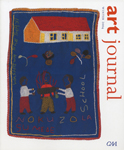
Winter 2004, Vol. 63, No. 4
In This Issue Patricia C. Phillips, Unsettled Imaginations, 3 Feature Raymond Spiteri, Envisioning Surrealism in Histoire de l’œil and La femme 100 têtes, 4 Artist Project Sze Tsung Leong, History Images, 19 Christopher Phillips, Drastic Urbanization: The Photographs of Sze

Winter 2004, Vol. 63, No. 4
In This Issue Patricia C. Phillips, Unsettled Imaginations, 3 Feature Raymond Spiteri, Envisioning Surrealism in Histoire de l’œil and La femme 100 têtes, 4 Artist Project Sze Tsung Leong, History Images, 19 Christopher Phillips, Drastic Urbanization: The Photographs of Sze
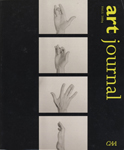
Fall 2004, Vol. 63, No. 3
In This Issue Patricia C. Phillips, Art and Risk, 3 Features Alejandro Anreus, The Road to Dystopia: The Paintings of Antonia Eiriz, 4 Branislav Jakovljevic, Unframe Malevich!—Ineffability and Sublimity in Suprematism, 18 Artist Project Eve Andrée Laramée, Netherzone: A Psychogeographical

Fall 2004, Vol. 63, No. 3
In This Issue Patricia C. Phillips, Art and Risk, 3 Features Alejandro Anreus, The Road to Dystopia: The Paintings of Antonia Eiriz, 4 Branislav Jakovljevic, Unframe Malevich!—Ineffability and Sublimity in Suprematism, 18 Artist Project Eve Andrée Laramée, Netherzone: A Psychogeographical
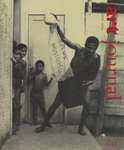
Summer 2004, Vol. 63, No. 2
In This Issue Patricia C. Phillips, Questions of Influence: Influence of Questions, 3 Feature Derek Conrad Murray, Hip-Hop vs. High Art: Notes on Race as Spectacle, 4 Thematic Investigation, James Meyer and Toni RossAesthetic/Anti-Aesthetic: An Introduction, 20 Arthur C. Danto,

Summer 2004, Vol. 63, No. 2
In This Issue Patricia C. Phillips, Questions of Influence: Influence of Questions, 3 Feature Derek Conrad Murray, Hip-Hop vs. High Art: Notes on Race as Spectacle, 4 Thematic Investigation, James Meyer and Toni RossAesthetic/Anti-Aesthetic: An Introduction, 20 Arthur C. Danto,
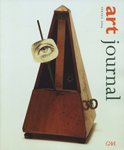
Spring 2004, Vol. 63, No. 1
In This Issue Patricia C. Phillips, Aesthetic Practices, 3 Features Janine Mileaf, Between You and Me: Man Ray’s “Object to be Destroyed”, 4 Jordana Mendelson, Joan Miró’s “Drawing-Collage,” August 8, 1933: The “Intellectual Obscenities” of Postcards, 24 Project Nato Thompson,

Spring 2004, Vol. 63, No. 1
In This Issue Patricia C. Phillips, Aesthetic Practices, 3 Features Janine Mileaf, Between You and Me: Man Ray’s “Object to be Destroyed”, 4 Jordana Mendelson, Joan Miró’s “Drawing-Collage,” August 8, 1933: The “Intellectual Obscenities” of Postcards, 24 Project Nato Thompson,

Winter 2005, Vol. 64, No. 4
In This Issue Patricia C. Phillips, Reconciliations: New Views and Re-views, 3 Artist Project Mary Lum, 64 Scenes (with an essay by Steven Nelson), 4 Features Roxana Marcoci, Perceptions at Play: Giacometti through Contemporary Eyes, 6 Rebecca M. Brown, P.T.

Winter 2005, Vol. 64, No. 4
In This Issue Patricia C. Phillips, Reconciliations: New Views and Re-views, 3 Artist Project Mary Lum, 64 Scenes (with an essay by Steven Nelson), 4 Features Roxana Marcoci, Perceptions at Play: Giacometti through Contemporary Eyes, 6 Rebecca M. Brown, P.T.

Fall 2005, Vol. 64, No. 3
In This Issue Patricia C. Phillips, Something to Talk About, 3 Artist Project Barbara Bloom, Commemorative Stamps, Art Journal 1929–2005, 4 Features Patricia C. Phillips, The Aesthetics of Witnessing: A Conversation with Alfredo Jaar, 6 David Levi Strauss and Daniel

Fall 2005, Vol. 64, No. 3
In This Issue Patricia C. Phillips, Something to Talk About, 3 Artist Project Barbara Bloom, Commemorative Stamps, Art Journal 1929–2005, 4 Features Patricia C. Phillips, The Aesthetics of Witnessing: A Conversation with Alfredo Jaar, 6 David Levi Strauss and Daniel

Summer 2005, Vol. 64, No. 2
In This Issue Patricia C. Phillips, Questions of Seeing, 3 Features Peter Erickson, Respeaking Othello in Fred Wilson’s Speak of Me as I Am, 4 Natalie Kosoi, Nothingness Made Visible: The Case of Rothko’s Paintings, 20 Peggy Phelan, Kevin Concannon,

Summer 2005, Vol. 64, No. 2
In This Issue Patricia C. Phillips, Questions of Seeing, 3 Features Peter Erickson, Respeaking Othello in Fred Wilson’s Speak of Me as I Am, 4 Natalie Kosoi, Nothingness Made Visible: The Case of Rothko’s Paintings, 20 Peggy Phelan, Kevin Concannon,
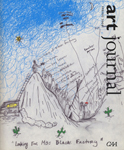
Spring 2005, Vol. 64, No. 1
In This Issue Patricia C. Phillips, Art of Attention, 3 Features Steven Nelson, Transgressive Transcendence in the Photographs of Rotimi Fani-Kayode, 4 Elizabeth Mansfield, The New Iconoclasm, 20 Richard Meyer, Slasher Story, 32 Daniel Joseph Martinez and David Levi Strauss,

Spring 2005, Vol. 64, No. 1
In This Issue Patricia C. Phillips, Art of Attention, 3 Features Steven Nelson, Transgressive Transcendence in the Photographs of Rotimi Fani-Kayode, 4 Elizabeth Mansfield, The New Iconoclasm, 20 Richard Meyer, Slasher Story, 32 Daniel Joseph Martinez and David Levi Strauss,
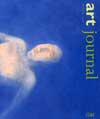
Winter 2006, Vol. 65, No. 4
In This Issue Patricia C. Phillips, On Locations, 5 Features Simone Osthoff, Elsewhere in Contemporary Art: Topologies of Artists’ Works, Writings, and Archives, 6 Marquard Smith, Journeys, Documenting, Indexing, Archives, and Practice-Based Research: A Conversation with susan pui san lok,

Winter 2006, Vol. 65, No. 4
In This Issue Patricia C. Phillips, On Locations, 5 Features Simone Osthoff, Elsewhere in Contemporary Art: Topologies of Artists’ Works, Writings, and Archives, 6 Marquard Smith, Journeys, Documenting, Indexing, Archives, and Practice-Based Research: A Conversation with susan pui san lok,
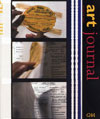
Winter 2007, Vol. 66, No. 4
In This Issue Judith F. Rodenbeck, Blindsight and Microblindness, 5 Features Jane Blocker, Blink: The Viewer as Blind Man in Installation Art, 6 Una Chung, What. Comes. After.: An Introduction to Lin + Lam’s Unidentified Vietnam, 22 Lin + Lam,

Winter 2007, Vol. 66, No. 4
In This Issue Judith F. Rodenbeck, Blindsight and Microblindness, 5 Features Jane Blocker, Blink: The Viewer as Blind Man in Installation Art, 6 Una Chung, What. Comes. After.: An Introduction to Lin + Lam’s Unidentified Vietnam, 22 Lin + Lam,

Fall 2006, Vol. 65, No. 3
In This Issue Patricia C. Phillips, Remediations—Re-viewing Art, 5 Features Frazer Ward, Alien Durations: Tehching Hsieh, 1978–99, 6 Anna Hammond, Ian Berry, Sheryl Cokelton, Sharon Corwin, Pamala Franks, katherine Hart, Wynona Lynch-McWhite, Charles Reeve, and John Stomberg, The Role of

Fall 2006, Vol. 65, No. 3
In This Issue Patricia C. Phillips, Remediations—Re-viewing Art, 5 Features Frazer Ward, Alien Durations: Tehching Hsieh, 1978–99, 6 Anna Hammond, Ian Berry, Sheryl Cokelton, Sharon Corwin, Pamala Franks, katherine Hart, Wynona Lynch-McWhite, Charles Reeve, and John Stomberg, The Role of

Summer 2006, Vol. 65, No. 2
In This Issue Patricia C. Phillips, Art That Insists: Persistence with Urgency, 5 Features Perry Bard,

Summer 2006, Vol. 65, No. 2
In This Issue Patricia C. Phillips, Art That Insists: Persistence with Urgency, 5 Features Perry Bard,
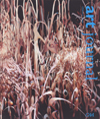
Spring 2006, Vol. 65, No. 1
In This Issue Patricia C. Phillips, Positionings, 5 Features David Raskin, The Shiny Illusionism of Krauss and Judd, 6 Derek Conrad Murray and Soraya Murray, Uneasy Bedfellows: Canonical Art Theory and the Politics of Identity, 22 Artists’ Project Helaine Posner,

Spring 2006, Vol. 65, No. 1
In This Issue Patricia C. Phillips, Positionings, 5 Features David Raskin, The Shiny Illusionism of Krauss and Judd, 6 Derek Conrad Murray and Soraya Murray, Uneasy Bedfellows: Canonical Art Theory and the Politics of Identity, 22 Artists’ Project Helaine Posner,

Fall 2007, Vol. 66, No. 3
In This Issue Judith F. Rodenbeck, Contingency and Engagement, 5 Features Martha Gever, Like TV: On Barbara Kruger’s Twelve, 6 Kate Mondloch, Be Here (and There) Now: The Spatial Dynamics of Screen-Reliant Installation Art, 20 Forum: The Look of Law

Fall 2007, Vol. 66, No. 3
In This Issue Judith F. Rodenbeck, Contingency and Engagement, 5 Features Martha Gever, Like TV: On Barbara Kruger’s Twelve, 6 Kate Mondloch, Be Here (and There) Now: The Spatial Dynamics of Screen-Reliant Installation Art, 20 Forum: The Look of Law
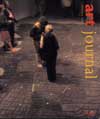
Summer 2007, Vol. 66, No. 2
In This Issue Judith F. Rodenbeck, Crossing Memory’s Green Line—Contemporary Art in Beirut, 5 Features Sarah RogersOut of History: Postwar Art in Beirut, 8 Laura U. Marks, Dangerous Gifts: Lamia Joreige’s Objects of War, 21 Lamia Joreige, Objects of War,

Summer 2007, Vol. 66, No. 2
In This Issue Judith F. Rodenbeck, Crossing Memory’s Green Line—Contemporary Art in Beirut, 5 Features Sarah RogersOut of History: Postwar Art in Beirut, 8 Laura U. Marks, Dangerous Gifts: Lamia Joreige’s Objects of War, 21 Lamia Joreige, Objects of War,
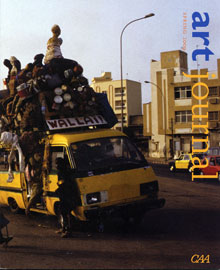
Spring 2009, Vol. 68, No. 1
In This Issue Judith F. Rodenbeck, Retooling, 5 Features Joanna Grabski, Urban Claims and Visual Sources in the Making of Dakar’s Art World City, 6 Gail Gelburd, Cuba and the Art of “Trading with the Enemy”, 24 Susette S. Min,

Spring 2009, Vol. 68, No. 1
In This Issue Judith F. Rodenbeck, Retooling, 5 Features Joanna Grabski, Urban Claims and Visual Sources in the Making of Dakar’s Art World City, 6 Gail Gelburd, Cuba and the Art of “Trading with the Enemy”, 24 Susette S. Min,

Spring 2007, Vol. 66, No. 1
In This Issue Patricia C. Phillips, The Exquisite and Urgent Importance of Art, 5 Features Matthew Gehring, Words of Art, 8 Rachel Weiss, Visions, Valves, and Vestiges: The Curdled Victories of the Bienal de La Habana, 10 Robert Blackson, Once

Spring 2007, Vol. 66, No. 1
In This Issue Patricia C. Phillips, The Exquisite and Urgent Importance of Art, 5 Features Matthew Gehring, Words of Art, 8 Rachel Weiss, Visions, Valves, and Vestiges: The Curdled Victories of the Bienal de La Habana, 10 Robert Blackson, Once

Fall 2010, Vol. 69, No. 3
In This Issue Katy Siegel, War and Other Disasters, 5 Features Kerry James Marshall, P-Van, from Dailies, inside covers Walid Raad, Appendix XVIII: Plates 88–107, 7 David McCarthy, David Smith’s Spectres of War and Peace, 20 Cécile Whiting, California War

Fall 2010, Vol. 69, No. 3
In This Issue Katy Siegel, War and Other Disasters, 5 Features Kerry James Marshall, P-Van, from Dailies, inside covers Walid Raad, Appendix XVIII: Plates 88–107, 7 David McCarthy, David Smith’s Spectres of War and Peace, 20 Cécile Whiting, California War


